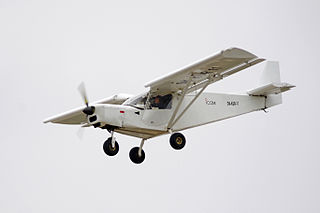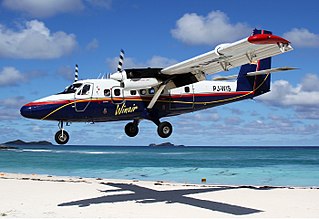Related Research Articles

A short takeoff and landing (STOL) aircraft is a conventional fixed-wing aircraft that has short runway requirements for takeoff and landing. Many STOL-designed aircraft also feature various arrangements for use on airstrips with harsh conditions. STOL aircraft, including those used in scheduled passenger airline operations, have also been operated from STOLport airfields which feature short runways.

An amphibious aircraft, or amphibian, is an aircraft that can take off and land on both solid ground and water. These aircraft are typically fixed-wing, though amphibious helicopters do exist as well. Fixed-wing amphibious aircraft are seaplanes which are equipped with retractable wheels, at the expense of extra weight and complexity, plus diminished range and fuel economy compared with planes designed specifically for land-only or water-only operation. Some amphibians are fitted with reinforced keels which act as skis, allowing them to land on snow or ice with their wheels up.

Landing gear is the undercarriage of an aircraft or spacecraft that is used for taxiing, takeoff or landing. For aircraft it is generally needed for both. It was also formerly called alighting gear by some manufacturers, such as the Glenn L. Martin Company. For aircraft, Stinton makes the terminology distinction undercarriage (British) = landing gear (US).

The de Havilland Canada DHC-6 Twin Otter is a Canadian STOL utility aircraft developed by de Havilland Canada in the mid-1960s and still in production today. De Havilland Canada produced it from 1965 to 1988; Viking Air purchased the type certificate, then restarted production in 2008 before re-adopting the DHC name in 2022. In 2023 DHC restarted production of the 300 series, in addition to the Series 400 produced by Viking. The aircraft's fixed tricycle undercarriage, STOL capabilities, twin turboprop engines and high rate of climb have made it a successful commuter airliner, typically seating 18–20 passengers, as well as a cargo and medical evacuation aircraft. In addition, the Twin Otter has been popular with commercial skydiving operations, and is used by the United States Army Parachute Team and the 98th Flying Training Squadron of the United States Air Force.

The de Havilland Canada DHC-3 Otter is a single-engined, high-wing, propeller-driven, short take-off and landing (STOL) aircraft developed by de Havilland Canada. It was conceived to be capable of performing the same roles as the earlier and highly successful Beaver, including as a bush plane, but is overall a larger aircraft.

Golden West Airlines was a commuter airline that operated flights on a high volume schedule in California. It ceased operations in 1983.

A bush airplane is a general aviation aircraft used to provide both scheduled and unscheduled passenger and flight services to remote, undeveloped areas, such as the Canadian north or bush, Alaskan tundra, the African bush, or savanna, Amazon rainforest and the Australian Outback. They are used where ground transportation infrastructure is inadequate or does not exist.

The Dornier 228 is a twin-turboprop STOL utility aircraft, designed and first manufactured by Dornier GmbH from 1981 until 1998. Two hundred and forty-five were built in Oberpfaffenhofen, Germany. In 1983, Hindustan Aeronautics Limited (HAL) bought a production licence and manufactured another 125 aircraft in Kanpur, Uttar Pradesh, India. In July 2017, 63 aircraft were still in airline service.
De Havilland Aircraft of Canada Limited (DHC) is a Canadian aircraft manufacturer that has produced numerous aircraft models since its inception including the popular Dash 8. The company's primary facilities were located in the Downsview area of Toronto, Ontario for many years; in 2022, it was announced that it would relocate primary manufacturing to De Havilland Field, under development near Calgary, Alberta. The aircraft types currently in production or planned for production include the DHC-6 Twin Otter, DHC-8 Dash 8, and DHC-515 Firefighter.

Air Tindi is an airline based in Yellowknife, Northwest Territories, Canada. It operates scheduled and on demand charter services. Its main base is Yellowknife Airport and the airline was previously owned by the Arychuk family. The name Tindi means "the big lake" or "Great Slave Lake" in the local native Tłı̨chǫ Yatiì language.

Linea Turistica Aereotuy LTA, C.A. was a Venezuelan regional and domestic airline headquartered in Caracas and based at Simón Bolívar International Airport.
Corporate Air is an airline based in Billings, Montana, United States. It was established in 1981 and operates primarily domestic scheduled cargo services, feeder service on behalf of FedEx Express, as well as the United States Postal Service. Its main base is Billings Logan International Airport.

Norcanair was the name of a Canadian airline that existed from 1947 to 1987, and again briefly in the early 1990s and from 2001 to 2005.

Tenzing-Hillary Airport, also known as Lukla Airport, is a domestic airport and altiport in the town of Lukla, in Khumbu Pasanglhamu, Solukhumbu District, Koshi Province of Nepal. It gained worldwide fame as it was rated the most dangerous airport in the world for more than 20 years by a program titled Most Extreme Airports, broadcast on The History Channel in 2010.
Viking Air Ltd. was an operator and manufacturer of aircraft, as well as aircraft parts and systems, based at Victoria International Airport in North Saanich, British Columbia, Canada. The company provides upgrades to the DHC-2 Beaver, spare parts for older de Havilland Canada aircraft, and components for Bell Helicopter Textron. The company operated as a subsidiary of De Havilland Canada until it was amalgated into it in August 2024.

Golden West Airlines Flight 261, a de Havilland Canada DHC-6 Twin Otter, collided with a Cessna 150 (N11421), owned by CessnAir Aviation, Inc., near Whittier, California. The accident occurred on January 9, 1975, at approximately 4:07 p.m. PST, while the Sun was just 9 degrees above the western horizon, directly into the eyes of the pilots of GW flight 261.
Rapt or RAPT may refer to:

Tara Air Pvt. Ltd. is an airline headquartered in Kathmandu, Nepal. It is a subsidiary of Yeti Airlines. Tara Air was formed in 2009 using aircraft from the Yeti Airlines fleet and is based at Tribhuvan International Airport, with a secondary hub at Nepalgunj Airport. The airline operates scheduled flights and air charter services with a fleet of STOL aircraft, previously provided by Yeti Airlines. Its operations focus on serving remote and mountainous airports and airstrips.

Honeywell Primus is a range of Electronic Flight Instrument System (EFIS) glass cockpits manufactured by Honeywell Aerospace. Each system is composed of multiple display units used as primary flight display and multi-function display.
References
- ↑ It's plane sailing for our engineering, University of Adelaide, April 2006
- ↑ "Tigerfish - an Idea That Floats, and Flies". Archived from the original on 2012-09-24.
- ↑ CFD Analysis of the Tigerfish Retractable Float System on a DHC-Twin Otter
- ↑ "CASE STUDIES - Partnering for Innovation" (PDF). Archived from the original (PDF) on 2011-10-03.